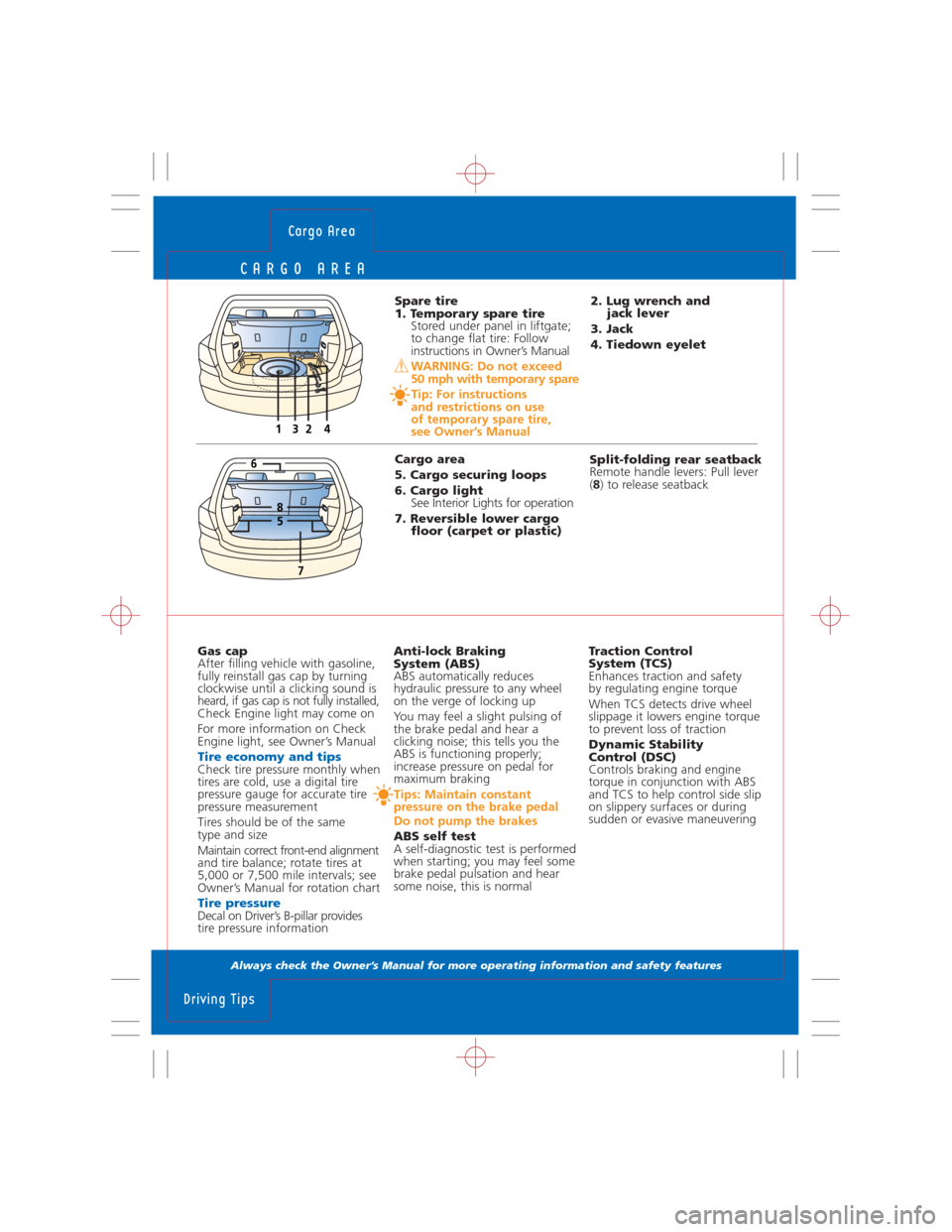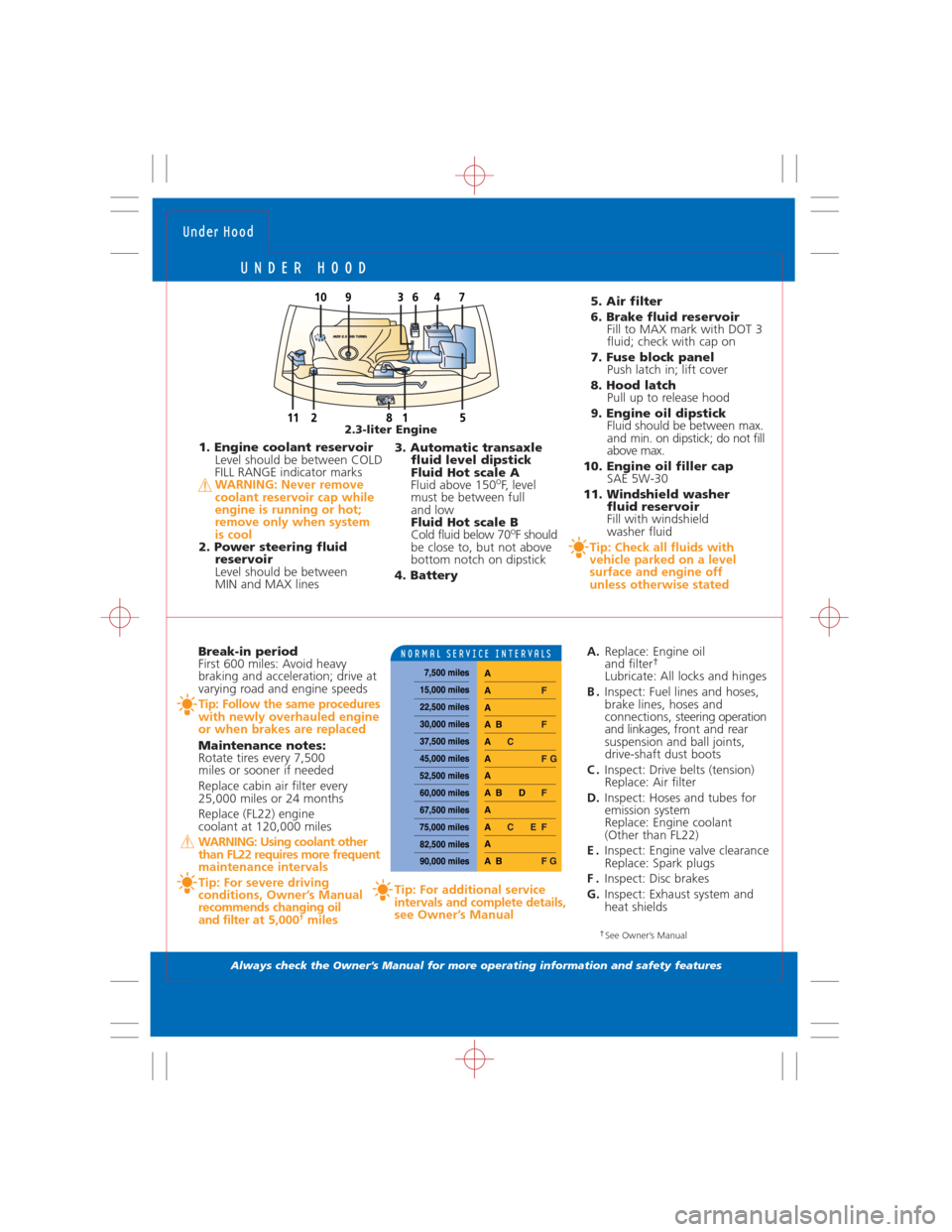MAZDA MODEL CX-7 2007 Quick Tips (in English)
Manufacturer: MAZDA, Model Year: 2007, Model line: MODEL CX-7, Model: MAZDA MODEL CX-7 2007Pages: 14, PDF Size: 1.77 MB
Page 11 of 14

CLIMATE CONTROLS
Always check the Owner’s Manual for more operating information and safety features
1. Air flow selections= air to dash
= air to dash and floor
= air to floor
= air to floor and windshield
= air to windshield (defrost)(Manual Climate Control) 6. Air intake control
Press switch to alternate
between recirculated (Indicator
light on) or outside (Indicator
light off) air mode
= recirculate inside air;
use for maximum cooling
WARNING: Do not use position in cold
weather, windows may
fog and hamper vision
Automatic operation
Press AUTO ( 10) for automatic
operation; rotate outer dial to set
temperature, refer to information
display for air flow selection, see
Owner's Manual
Tip: Automatic climate control
display viewed via information
display, see below
2. Fan control Rotate knob clockwise/
counterclockwise to increase/
decrease fan speed
3. Temperature control Cooler/warmer = rotate knob
counterclockwise/clockwise
4. A/C = air conditioner
Press to turn on/off
5. Rear window defogger Press on/off; shuts off with
ignition or automatically after
15 minutes of operation; also
operates heated outside mirrors*
7. AMB*Press AMB button ( 7) to display
ambient temperature, press again
to switch display to temperature
set for air conditioner
Tip: To change from
Fahrenheit to Centigrade or
vice versa: Press AMB button
(7) for 3 seconds or more
8. Windshield defroster switch
Press: Fresh air position is
automatically selected, A/C
automatically turns ON
9. OFF Press to turn system OFF
Control positions for
maximum defrost
Fan to maximum, temperature
to maximum hot, selected
Tip: To help prevent
windshield fogging in
humid weather, select
before starting engine
To prevent moisture buildup,
never drive with system off
Objects placed under the
front seats may interfere
with air flow to the rear
Information DisplayInformation display ( 1) has
the following functions: Clock,
audio display, automatic climate
control display* and ambient/cabin
temperature display* (AMB)Tip: Manual climate
control not viewable via
information display
Climate
Controls
Information Display
04 13
2
321
645
A/CA/C AMB
CHPUSHAUTOPUSHOFFFRONTMOD
E
4657910
2381
Manual A/C Automatic A/C*
*Denotes optional equipment
88:88 FM1 88.9 88.8CHDISC IN MD W ST RPT RDM AUTO-M8AMB FOAUTOA/C ECO1
Page 12 of 14

AM/FM STEREO/CD/CD CHANGER
Always check the Owner’s Manual for more operating information and safety features
6. SEEK/TRACKRadio: Press to
automatically seek higher/
lower frequency
CD: Press to select next
track/beginning of current track
7. LOAD* To load multiple discs:
Press and hold LOAD ( 7) until
beep sound is heard; insert
CD when “IN” is indicated on
information display ( 20)
To eject disc: Press Eject ( 15)
To eject specific disc: Press
and hold Eject ( 15) until beep
sound is heard; within five
seconds press the desired tray
number 1-6 ( 16)
/
/
1. Power/Volume
Press to turn on/off; rotate
to increase/decrease volume
2. Random Press to play CD selections
in random order, press again
to cancel
3. Program
†4. Auto-Memory Press and hold until a beep sound
is heard; system automatically
scans and temporarily stores six
strong stations in each band;
press again to switch to another
preset station
DISP
CD: Press repeatedly to scroll
through displays
Text* : Rotate right/left to display
titles longer than 12 characters
5. Tune Radio: Rotate counter
clockwise/clockwise for lower/
higher frequency
10. FM/AMPress to turn radio on and
select between FM1/FM2/AM
station preset buttons ( 16)
11. CD slot
12. SAT*, Satellite ready capability
13. CD, Press to play CD
14. Media
†
15. CD eject button
16. Memory preset buttons To set: Tune to station, press and
hold until beep sound is heard
17. Disc / * Press to skip to next/previous CD
18. Audio control Audio: Press to select ALC/BASS/
TREB/FADE/BAL/BEEP/Surround*
OFF/1/2/3, rotate right/left to
adjust selected feature
Tip: Automatic Level Control
(ALC) automatically adjusts
audio volume depending
on vehicle speed
8. ScanRadio: Press to sample
strong stations, press again
to stop at current station
CD: Press to play first few seconds
of each selection, press again
to stop at current selection
9. RPT Press to replay current
CD selection
Clock**To set: With ignition in ACC
or ON position, press ( A) and
hold until beep sounds; 12hr/24hr
will appear on display ( 20); press
( B ) to select; press ( A) again while
selection is flashing: Hr ADJUST
displays; press ( B) to select hour;
press ( A) when done, do the
same to set minutes
Navigation/Audio System*AudioPilot* (BOSE system)
Automatically adjusts audio volume
in accordance with level of noise
entering vehicle; press on-screen
button to turn ON/OFF
Centerpoint* (BOSE system)
Delivers multi-channel surround
sound while listening to CDs
See Owner's Manual for
complete details
19.
Reverse / Fast forward
Press to reverse/fast forward
through a track
20. Display,
see Information Display
Audio
Systems
Audio
Systems
LOAD
CLOCK S
ET
SCANTRACK
S EE K APCRPT
PROG RDM FM/AM SAT CD M
EDIA VOL
PUSH POWERDISC
DISC123 6
45
910111213BA14
1845231
78
6
16
17
15
19
88:88 FM1 88.9 88.8CHDISC IN MD W ST RPT RDM AUTO-M8AMB FOAUTOA/C ECO20
TEXT
PUSH AUDIO CONT TUNE PUSH AUTO-M.DISP.ESN
*Denotes optional equipment
**See Navigation Owner’s Manual for clock setting procedure if
equipped with Navigation System
†Not functional in U.S. market
Page 13 of 14

CARGO AREA
Always check the Owner’s Manual for more operating information and safety features
Cargo Area
Driving Tips
Spare tire
1. Temporary spare tire
Stored under panel in liftgate;
to change flat tire: Follow
instructions in Owner’s Manual
WARNING: Do not exceed
50 mph with temporary spare
Tip: For instructions
and restrictions on use
of temporary spare tire,
see Owner’s Manual
Gas cap
After filling vehicle with gasoline,
fully reinstall gas cap by turning
clockwise until a clicking sound is
heard, if gas cap is not fully installed,
Check Engine light may come on
For more information on Check
Engine light, see Owner’s Manual
Tire economy and tipsCheck tire pressure monthly when
tires are cold, use a digital tire
pressure gauge for accurate tire
pressure measurement
Tires should be of the same
type and size
Maintain correct front-end alignment
and tire balance; rotate tires at
5,000 or 7,500 mile intervals; see
Owner’s Manual for rotation chart
Tire pressure Decal on Driver’s B-pillar provides
tire pressure informationAnti-lock Braking
System (ABS)
ABS automatically reduces
hydraulic pressure to any wheel
on the verge of locking up
You may feel a slight pulsing of
the brake pedal and hear a
clicking noise; this tells you the
ABS is functioning properly;
increase pressure on pedal for
maximum braking
Tips: Maintain constant
pressure on the brake pedal
Do not pump the brakes
ABS self test
A self-diagnostic test is performed
when starting; you may feel some
brake pedal pulsation and hear
some noise, this is normal2. Lug wrench and
jack lever
3. Jack
4. Tiedown eyelet
Cargo area
5. Cargo securing loops
6. Cargo light
See Interior Lights for operation
7. Reversible lower cargo
floor (carpet or plastic)Split-folding rear seatback
Remote handle levers: Pull lever
(8) to release seatback
6
58
7
1324
Traction Control
System (TCS)
Enhances traction and safety
by regulating engine torque
When TCS detects drive wheel
slippage it lowers engine torque
to prevent loss of traction
Dynamic Stability
Control (DSC)
Controls braking and engine
torque in conjunction with ABS
and TCS to help control side slip
on slippery surfaces or during
sudden or evasive maneuvering
Page 14 of 14

UNDER HOOD
Always check the Owner’s Manual for more operating information and safety features
Under Hood
1. Engine coolant reservoir
Level should be between COLD
FILL RANGE indicator marks
WARNING: Never remove
coolant reservoir cap while
engine is running or hot;
remove only when system
is cool
2. Power steering fluid
reservoir
Level should be between
MIN and MAX lines
Break-in period
First 600 miles: Avoid heavy
braking and acceleration; drive at
varying road and engine speeds
Tip: Follow the same procedures
with newly overhauled engine
or when brakes are replaced
Maintenance notes:
Rotate tires every 7,500
miles or sooner if needed
Replace cabin air filter every
25,000 miles or 24 months
Replace (FL22) engine
coolant at 120,000 miles
WARNING: Using coolant other
than FL22 requires more frequent
maintenance intervals
Tip: For severe driving
conditions, Owner’s Manual
recommends changing oil
and filter at 5,000
†milesTip: For additional service
intervals and complete details,
see Owner’s Manual
3. Automatic transaxle
fluid level dipstick
Fluid Hot scale A
Fluid above 150
oF, level
must be between full
and low
Fluid Hot scale B
Cold fluid below 70
oF should
be close to, but not above
bottom notch on dipstick
4. Battery
A.Replace: Engine oil
and filter
†Lubricate: All locks and hinges
B.Inspect: Fuel lines and hoses,
brake lines, hoses and
connections, steering operation
and linkages, front and rear
suspension and ball joints,
drive-shaft dust boots
C.Inspect: Drive belts (tension)
Replace: Air filter
D.Inspect: Hoses and tubes for
emission system
Replace: Engine coolant
(Other than FL22)
E.Inspect: Engine valve clearance
Replace: Spark plugs
F.Inspect: Disc brakes
G.Inspect: Exhaust system and
heat shields 5. Air filter
6. Brake fluid reservoir
Fill to MAX mark with DOT 3
fluid; check with cap on
7. Fuse block panel
Push latch in; lift cover
8. Hood latch
Pull up to release hood
9. Engine oil dipstick
Fluid should be between max.
and min. on dipstick; do not fill
above max.
10. Engine oil filler cap
SAE 5W-30
11. Windshield washer
fluid reservoir
Fill with windshield
washer fluid
Tip: Check all fluids with
vehicle parked on a level
surface and engine off
unless otherwise stated
610347
51211
9
82.3-liter Engine
†See Owner’s Manual
NORMAL SERVICE INTERVALS
7,500 miles
15,000 miles
22,500 miles
30,000 miles
37,500 miles
45,000 miles
52,500 miles
60,000 miles
67,500 miles
75,000 miles
82,500 miles
90,000 miles
A BF G A A
C E F
A A
B D F A A
F G A C A
BF
A A F A